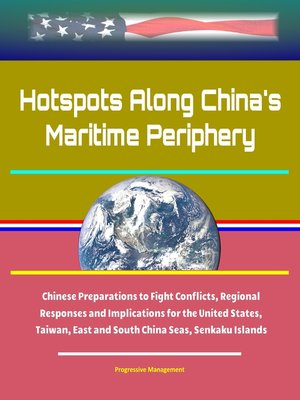Hotspots Along China's Maritime Periphery
ebook ∣ Chinese Preparations to Fight Conflicts, Regional Responses and Implications for the United States, Taiwan, East and South China Seas, Senkaku Islands

Sign up to save your library
With an OverDrive account, you can save your favorite libraries for at-a-glance information about availability. Find out more about OverDrive accounts.
Find this title in Libby, the library reading app by OverDrive.



Search for a digital library with this title
Title found at these libraries:
| Library Name | Distance |
|---|---|
| Loading... |
This authoritative report has been professionally converted for accurate flowing-text e-book format reproduction. It represents the testimony presented at the public hearing of the U.S. - China Economic And Security Review Commission. The subject of the hearing was an overview of China's simultaneous preparations for contingency operations that target U.S. allies, friends, and partners in the Asia-Pacific. It specifically examined Beijing's perception of security challenges posed by Taiwan and overlapping maritime claims in the East and South China seas, and how the People's Liberation Army plans to respond to those challenges. Additionally, this hearing explored the implications of potential Chinese aggression in this region for the United States and U.S. allies, partners, and friends should China initiate a conflict.
This compilation includes a reproduction of the 2019 Worldwide Threat Assessment of the U.S. Intelligence Community.
The Chinese Communist Party believes there are several threats that exist along China's maritime periphery. These threat perceptions have a defined geographic focus and are informed by fears about Taiwan independence, challenges to China's claims in the South China Sea, and Japan's administrative control of the Senkaku Islands in the East China Sea. They result in a set of potential "regional hotspots" for which the People's Liberation Army is actively preparing for contingency operations. These operations, if executed, could lead to armed conflicts between China and U.S. allies, friends and partners in the Asia Pacific and could trigger a U.S. military response.
Authoritative documents such as China's 2015 defense white paper identify several missions tasked to the PLA that directly apply to hotspot contingencies, such as safeguarding security and sovereignty along China's land and maritime borders, which would include claims to features in the East and South China Seas and "unification of the motherland," code for preventing Taiwan's independence.
To prepare for a potential crisis along China's maritime periphery, senior Chinese leaders have directed the PLA to develop contingency plans and expand its military capabilities. However, one of the most pressing concerns faced by PLA planners is the consideration that the U.S. will intervene in a conflict. This consideration has led the PLA to pursue a robust military modernization program that includes developing long-range strike capabilities to engage an adversary farther from China's coast, improving training to conduct joint warfighting operations and preparing to fight in new security domains such as space and cyberspace.
Therefore, to better understand the challenges the United States may face concerning Chinese activities around these hotspots, this hearing will examine Beijing's perceptions of the threat posed by sovereignty challenges in the East and South China Seas and vis-a-vis Taiwan, how the PLA plans to respond to these challenges, and the implications of a conflict in the region for the U.S.







